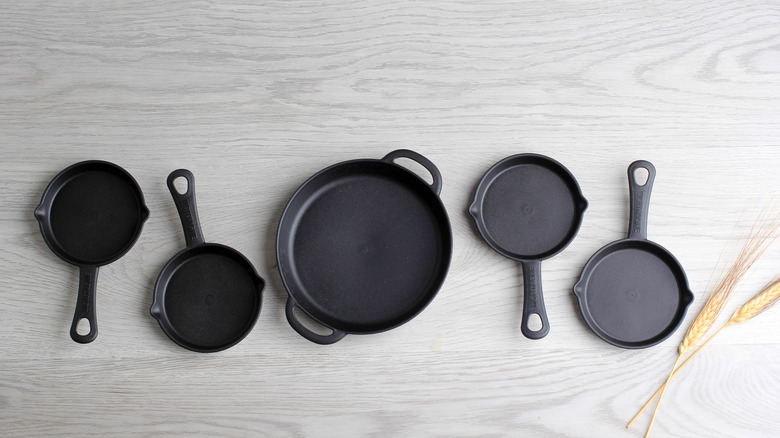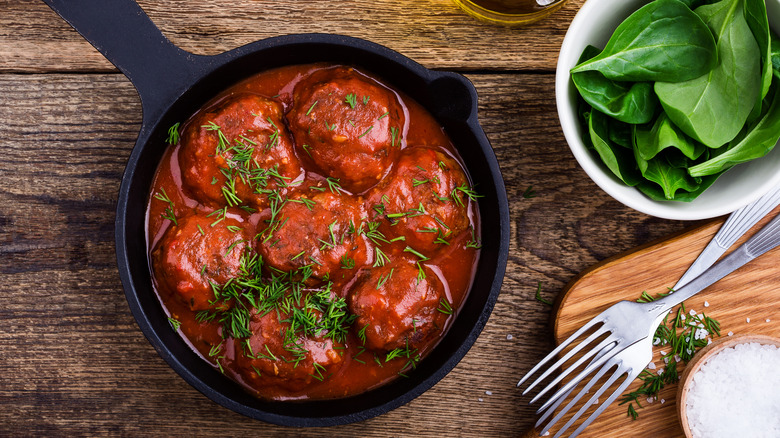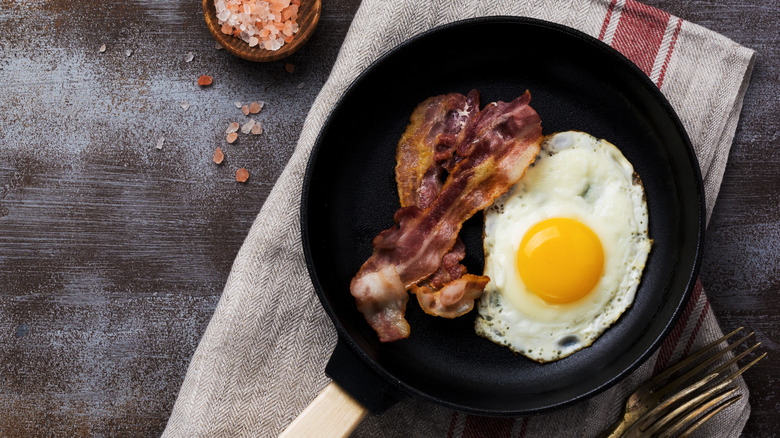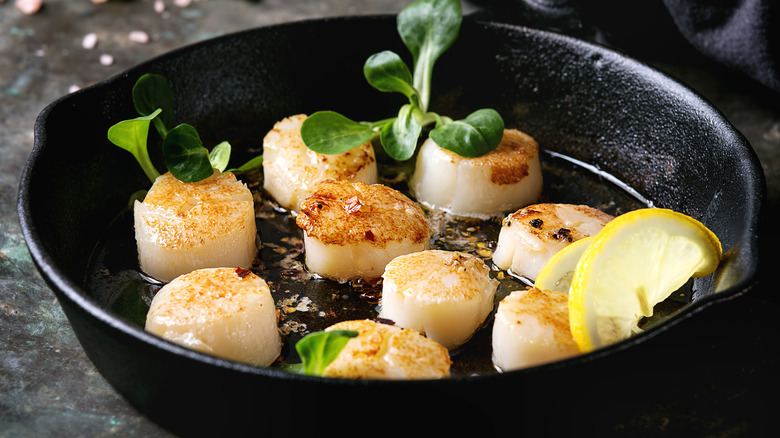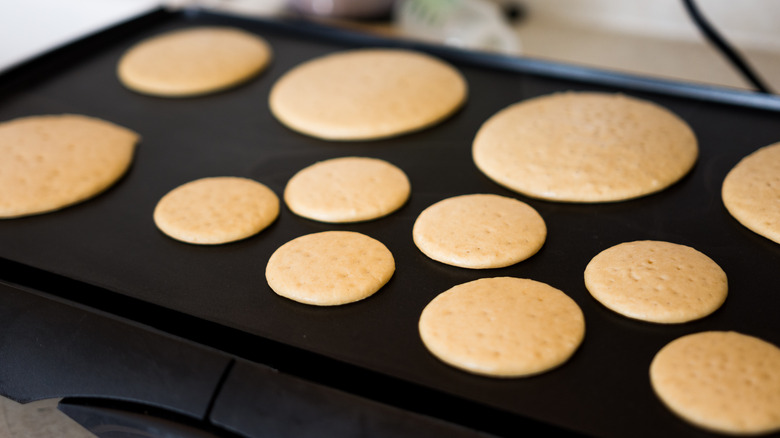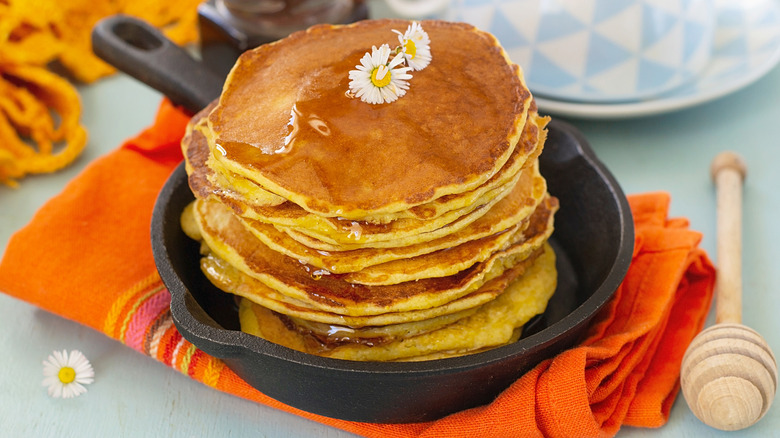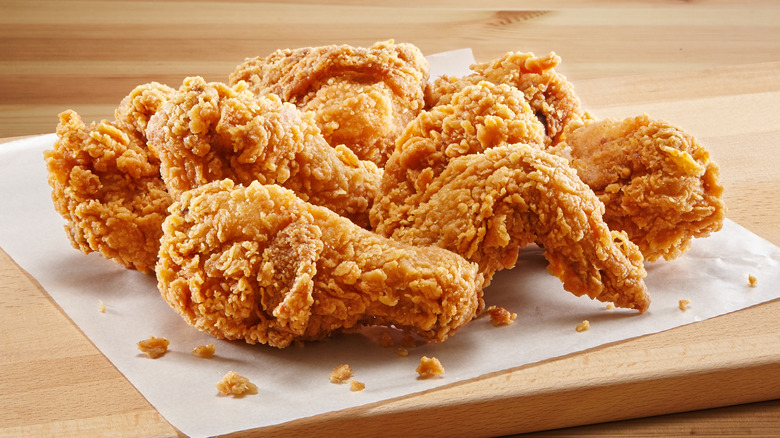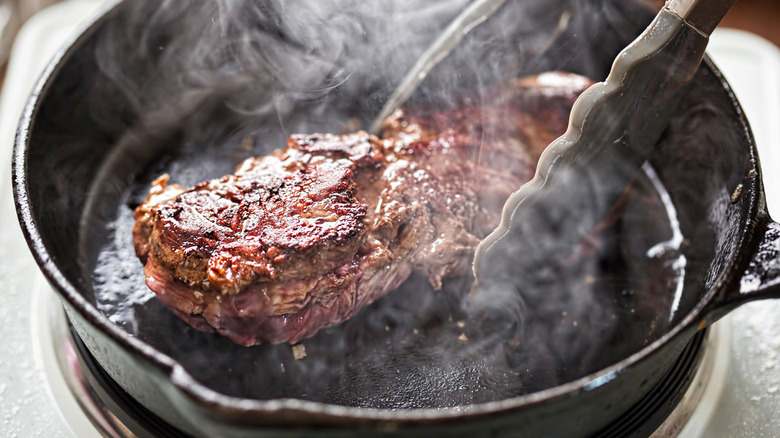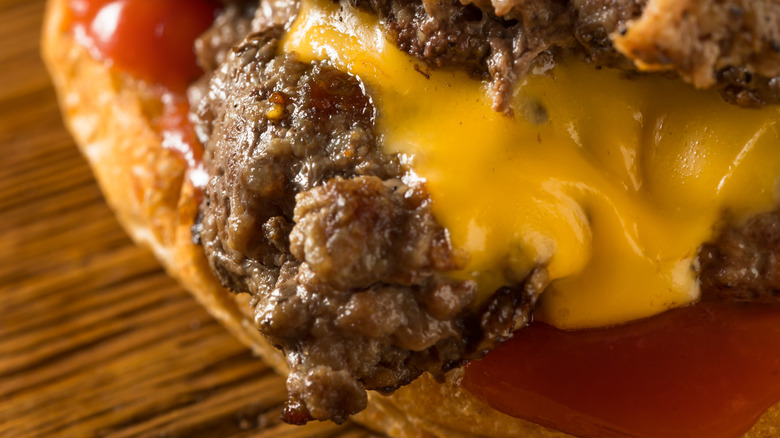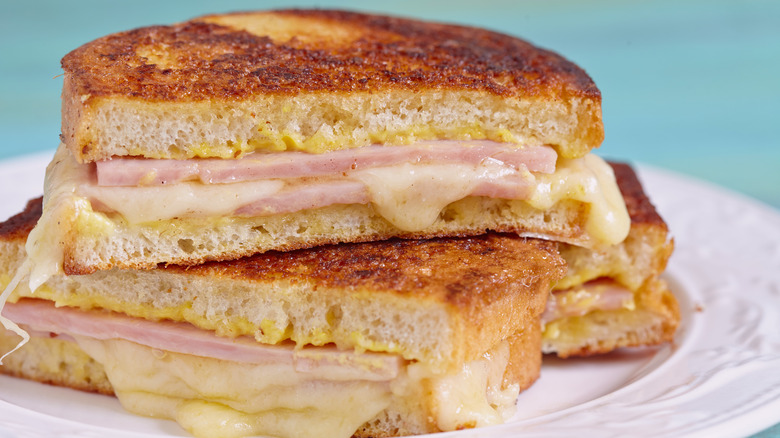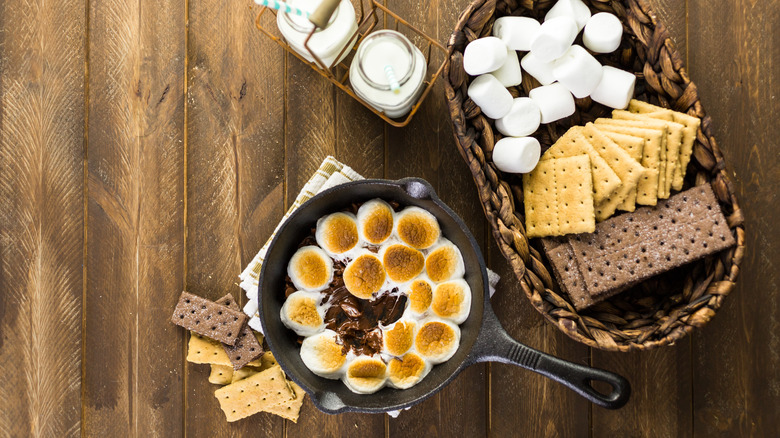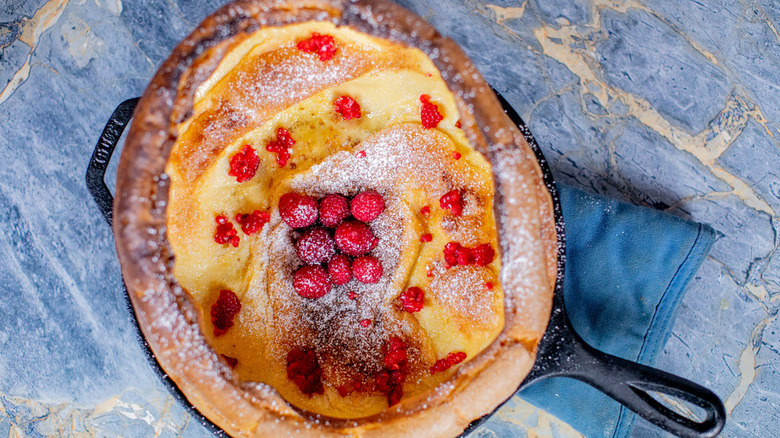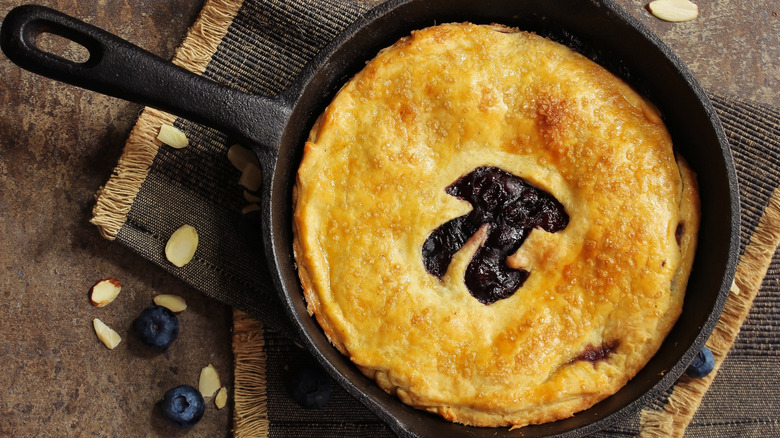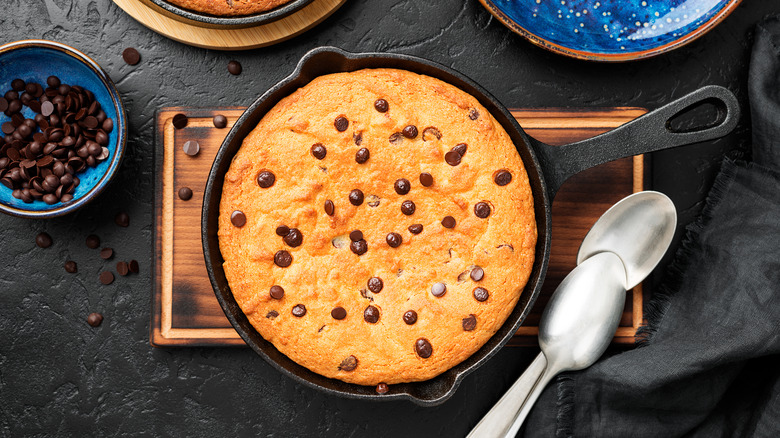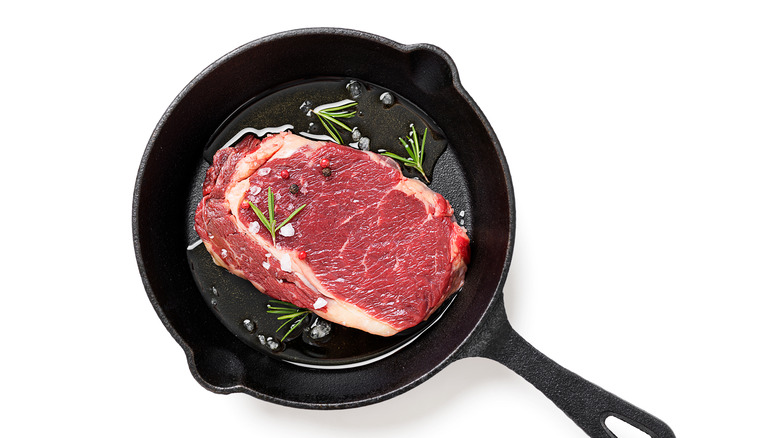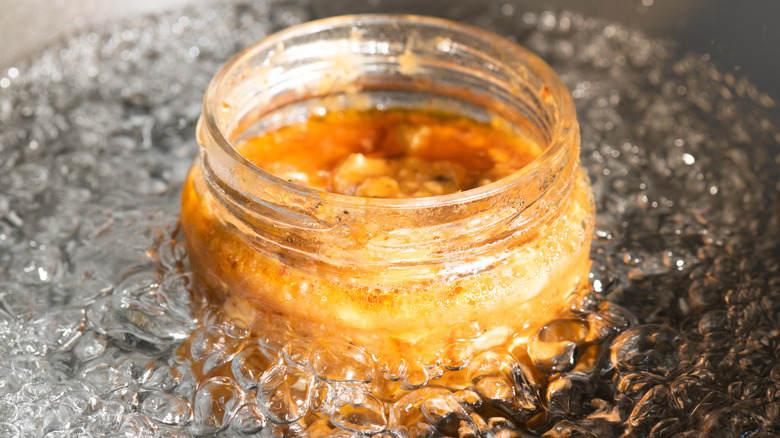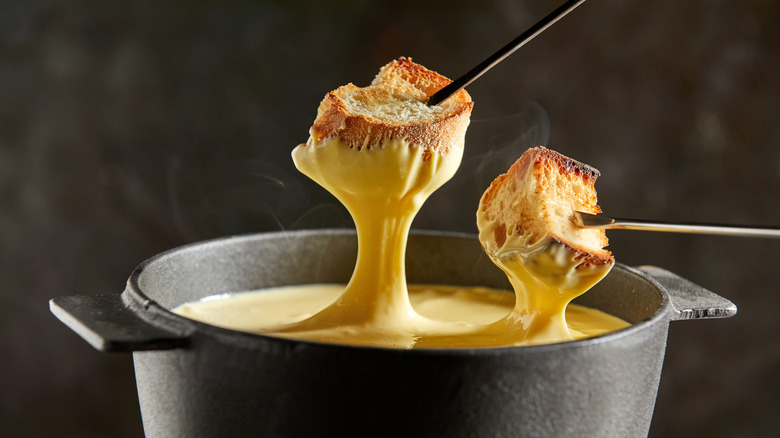17 Best Ways To Use Your Cast Iron Skillet
Cast iron cookware was a big innovation when it first came into being in the third century (via Web Restaurant Store). Prized for its heft, ability to heat to extremely high temperatures, and indestructibility, cast iron eventually became so integral to daily life that the economist Adam Smith, in his seminal 1776 book, "The Wealth of Nations" likened its value to society to that of gold (via The News Journal). Nevertheless, cast iron declined in popularity throughout the 20th century as more "advanced" cooking materials became available. That being said, other "advanced" innovations included plastic, diet soda, TV dinners, GMOs, and nuclear weapons.
At the turn of the millennium, as people began questioning whether innovation necessarily equals improvement, cast iron cookware came back into vogue — but not universally. Some complain it's hard to clean or too complicated to take care of. Others claim you "shouldn't" cook this or that food on cast iron. But that's not true either. Sure, challenges present themselves, but cast iron can handle practically anything you throw at it – with results superior to other surfaces. Read on for these best uses for your cast iron skillet that you probably never thought possible.
Use your cast iron skillet to make marinara
You have, no doubt, heard warnings never to use your cast iron skillet to cook tomatoes because their acid can leach iron from the pan and into your food, leaving a nasty taste. America's Test Kitchen sought to test that by simmering tomato sauce over medium heat in a well-seasoned cast iron skillet for at least 30 minutes. Testers found was that there was no discernable metallic taste to the tomato sauce — until the sauce had simmered for a full 30 minutes. Once the sauce had cooked for longer, however, metallic flavors did appear in the sauce.
What America's Test Kitchen concluded was that the seasoning on a cast iron skillet helps keep the acid from the tomatoes from interacting with the iron content of the skillet — up to a point. The upshot is that you can definitely use your well-seasoned cast iron skillet to make many tomato-based dishes. Just keep your simmering to no more than 30 minutes, don't store the leftovers in the skillet, and use baking soda to scrub out the skillet. Baking soda is a base, which will help neutralize any lingering acid.
Yes, you can make eggs in your cast iron
Forget what you've heard about not using your cast iron skillet for eggs. Cast iron is a perfect vessel for cooking eggs because it is so good at retaining temperature. That means that every time you cook your eggs, they're going to turn out pretty much the same. You just have to be willing to make a few modifications.
One is that you can't skimp on preheating your cast iron pan, which could take several minutes (via Lodge Cast Iron). Also, take your eggs out of the fridge a few minutes early. Letting them approach room temperature helps keep the eggs from sticking to the cast iron surface. Finally, you should only use a sturdy metal spatula when cooking eggs on cast iron. Only metal will properly dislodge eggs from the cast iron's surface. With those minor adjustments, you'll even be able to make scrambled eggs using your cast iron.
Go ahead and cook seafood in your cast iron
The taste and texture of seafood is greatly enhanced by cast iron cooking. So, it's unfortunate that some cast iron critics claim you should "never" cook fish and other seafood in a cast iron skillet, as it is supposedly too delicate to subject to cast iron's less-than-smooth surface. But if your fish is sticking to your cast iron, it is more likely the result of your not having cooked the fish long enough before you tried to flip it, or that you didn't use a metal spatula.
Some also claim that fish and seafood allegedly leave behind a stink that never quite goes away. But there are several ways to eradicate fish odors from cast iron, including scrubbing your skillet with baking soda (via World of Pans). If that strikes you as too labor-intensive, then you can take a page out of Cook's Illustrated and simply bake your clean, empty pan in a 400° Fahrenheit oven for 10 minutes.
You can also cook pancakes on cast iron
Pancakes cooked on cast iron just feel so much homier than pancakes cooked on non-stick surfaces. And that makes sense considering that pancakes have been around since the stone age, well before cookware was invented (via Coppersmith). If a hot rock could handle a pancake, then trust us, so can your cast iron skillet. You just have to keep a few fundamentals in mind.
Pancakes can't be cooked at just any old temperature. If you try to cook them at too high a temperature, they'll burn without cooking on the inside. If you overcompensate by lowering the heat too much, they don't really cook at all. Plus, pancakes cook best when the batter rests at room temperature before cooking. To make pancakes in your cast iron skillet, swipe the cold skillet with a bit of shortening and heat for at least five minutes on medium. Before you pour your batter, make sure a drop of water dances on its surface (rather than sizzling and disappearing). And, as with eggs and seafood, use a metal spatula.
The only authentic way to make hoecakes is using cast iron
Hoecakes are classic Southern fare that may look like pancakes but are most definitely not, according to Slate. Hoecakes are meant to be sturdy enough to act as a "shovel" for whatever else you're eating with them. According to their origin story, the "hoe" in their name refers to the flat, metal gardening implement — because they were supposedly first cooked on gardening hoes heated in the fireplace. Assuming you don't plan on using a garden hoe as a cooking implement, the next most authentic thing is a flat-bottomed cast iron griddle.
To whip up a batch, simply whisk a cup of cornmeal and a cup plus two tablespoons of boiling water. Allow the mixture to cool for 10 minutes while you heat up your cast iron skillet over medium heat and add a spoonful of oil. Pour the batter into six-inch circles and cook for 10 minutes. Flip with a metal spatula, cook for another eight to 10 minutes, and enjoy a plateful of authentic Americana.
Your cast iron skillet holds the secret to the best Southern fried chicken
Perhaps the best way to make Southern fried chicken is in your cast iron skillet — provided that your skillet has sides that are at least two inches tall. The reason is that cast iron is so good at retaining heat that your frying oil should not significantly drop in temperature when you add the chicken. In fact, cast iron skillets are sometimes referred to as "chicken fryers," according to Dummies, which suggests heating your frying oil to 375° Fahrenheit and using an instant-read thermometer to make sure it's reached that level before you start frying (and retains that same temperature as you continue frying).
And when you're done cooking, here's something else to be happy about: cooking with oil at that temperature will add a layer of seasoning to your cast iron skillet (via Field Company).
Use your cast iron skillet for perfect steak every time
While steak lovers will endlessly debate the "best" and "only" way to make a proper steak, the fact is that you can't go wrong using a cast iron skillet, according to LifeSavvy. Once it's heated it will reliably retain its heat. And when you're cooking steak, that matters a lot. Back in February 2021, Giada De Laurentiis blew the minds of fans of the "reverse sear" with an Instagram post explaining how she corrals the intense heat of a cast iron skillet to do everything a reverse sear does without opening the oven.
Simply massage olive oil and kosher salt onto both sides of a thick steak, heat your cast iron skillet to high, then add your steak and do absolutely nothing for three to five minutes. That's how long it will take for the salt, oil, and meat proteins to develop the perfect crust, which is not only your express elevator to Maillard heaven, but also works to suspend the steak ever-so-slightly off the skillet's surface.
Your cast iron is perfect for making smash-burgers
Lucky for burger lovers everywhere, Smashburger materialized in 2007, founded on the singular notion that burgers should be "smashed" into a patty shape with a spatula while cooking (via Smashburger). As it turned out, it's not the squishing, per se, that is problematic, but doing so over a slatted grill. That has the effect of releasing precious juices into the flames, diminishing the taste while also risking flare-ups and burned meat. And for anyone who isn't wedded to very-thick burger patties, there's a lot to be said for smashing a burger — which simply cries out for the reliably super-hot surface of a well-heated cast iron skillet.
First, the less you handle your ground beef, the more tender the burger. Skipping the by-hand patty-forming process eliminates a lot of handling. Second, smashing the burger on the hot grill directly exposes more meat to the heat, resulting in a larger surface area undergoing the Maillard reaction, which bestows an inimitable nutty, savory caramelized flavor.
Use your cast iron skillet like a panini press
Since we're on this topic of "pressing matters," we thought we'd share with you this genius use for your cast iron skillet — one which leverages the heft of cast iron, which came to us via America's Test Kitchen. Just as you can use your cast iron skillet for smashing burgers, you can also use it for pressing paninis. However, for optimal results, you will actually need two cast iron skillets.
Start by coating a large, seasoned cast iron skillet with oil and heating it over medium-high heat. While it's heating, make your sandwich. Assuming you've let your skillet get hot enough to toast bread, you're now ready to place your assembled sandwich on the skillet. Now, take your second cast iron, coat the clean bottom with oil, and place it on top of your sandwich. After a few minutes, the bottom of your sandwich should be a toasty golden-brown. That's when you should flip the sandwich over and repeat the process.
Cast iron makes indoor s'mores any time of year
It used to be that s'mores were a treat reserved for campfire season. Eventually, of course, people realized you could cheat your way to a s'more in the microwave, but since the process involved placing a cold sandwich into the microwave to melt, the process feels remote.
With a cast iron, however, you can have a s'mores-making experience that is as close to the campfire version as you can get without making an actual campfire. Simply lay your s'mores sandwiches onto a cold cast iron skillet, set the heat to medium, and watch as your s'mores come to life. If you want to use your cast iron to make s'mores for a crowd, preheat your oven to 450° Fahrenheit, break your chocolate into pieces, place them in your skillet, and top with marshmallows. Place in the oven for seven to nine minutes or until the marshmallows are golden brown. Serve with graham crackers for dipping.
A Dutch baby was meant to be cooked in a cast iron skillet
A Dutch baby is a "bready, buttery skillet full of deliciousness that when topped with fresh fruit and powdered sugar becomes a treat you and your (lucky) guests will long remember," according to Nathaniel Lee, the recipe developer who brought us this impeccable, surprisingly simple Dutch baby recipe. Technically, a Dutch baby is really just a crepe-like pancake (as opposed to a fluffy buttermilk pancake) that you cook in the oven without flipping. When done, it comes out lighter-than-air as a result of its high ratio of eggs to other ingredients.
While you could certainly make a Dutch baby in another oven-safe dish, the fact is that nothing compares to a Dutch baby cooked in a cast iron skillet. As Lee explained to Mashed, cast iron's ability to retain heat evenly enables your Dutch baby to rise properly without burning its edges.
Your cast iron skillet is a perfect stand-in for a pie tin
If you want to bake a pie and you don't have a pie pan on hand, you can certainly make do with one of those disposable pie tins you can find in your supermarket's baking aisle. But disposable tins tend to be flimsy and are often too shallow to contain a bubbling filling. So, to avoid a massive oven cleanup, you'll have to place your disposable tins on baking sheets, which also become part of your cleanup detail. So, does that mean you need to take up precious cupboard space with a designated pie pan?
Not if you have a cast iron skillet. Just make sure its diameter is consistent with your pie recipe (usually nine or 10 inches in diameter) so that you won't have to make any adjustments for recipe volume or baking time, as America's Test Kitchen advises.
Your cast iron skillet is the only thing you'll have to clean after making a chocolate chip cookie "pie"
Baking chocolate chip cookies ordinarily requires, in addition to the mixing of the dough, a laborious process of dishing out dough onto multiple cookie sheets. You can skip most of that work by using your cast iron skillet to make a single, giant chocolate chip cookie. "Plus, the hot bottom and tall sides of a well-seasoned cast iron create a great crust on the cookie. And this treat can go straight from the oven to the table for a fun, hands-on dessert.
To make a cast iron skillet chocolate chip cookie, you can use any recipe for chocolate chip cookies, including this incredible one. According to Very Best Baking, you don't need to make any recipe adjustments from your regular "cookie" recipe, but you do have to double your baking time.
Cast iron can quickly and safely thaw frozen meat
If it's almost dinner time, and you just realized that you forgot to defrost your meat, your first thought might be to make use of the defrost setting on your microwave. While that's a reasonable workaround, we have a much better one via America's Test Kitchen. Simply place "thin, frozen cuts of meat in the skillet at room temperature and let them sit for an hour." Et voila, you're ready to get cooking.
Cast iron is a brilliant conductor of heat, even at low temperatures. As your meat begins to defrost, the cast iron absorbs the rising temperature and holds onto it, rather than cooling off the way many other surfaces would, which then is absorbed back into the meat. As America's Test Kitchen explains, "the rapid transfer of ambient heat from the metal to the food will quickly, safely thaw the meat."
You can use your cast iron as a double boiler
A double boiler refers to a system of two pots, one fitting onto the top of the other, allowing food placed into the upper pot to steam or melt gently as water boils below (via Web Restaurant Store). Double boilers are the preferred method for melting chocolate and are also ideal for creating delicate sauces such as Hollandaise.
However, if you have a cast iron skillet and a mason jar — or any other heat-proof bowl-like container, you don't need an actual double boiler. Simply use your cast iron skillet — with its wonderful ability to retain and distribute heat — as the bottom pot. In many cases, you won't need to put any water in it at all. Using a low to medium flame, heat the skillet and then place a smaller pot or saucepan right on the surface (via America's Test Kitchen).
Your cast iron can double as a fondue pot
Cheese fondue, which was all the rage at dinner parties during the 1970s, is finally making a comeback in the U.S. But you don't need a fondue pot to make your own cheese fondue — not if you have a cast iron skillet, says Culture.
Simply rub a garlic clove inside your cast iron skillet, then chop it and add it to the skillet along with one-third cup of dry white wine and one tablespoon of whiskey. Bring to a boil over medium heat, then slowly add eight ounces of grated cheese and two teaspoons of cornstarch. Stir constantly, lowering the heat if the mixture begins to boil. As soon as the cheese is melted, remove the skillet from the heat and place it on a heat-proof surface. The fondue will stay hot and melty thanks to your cast iron skillet's ability to hold heat.
Turn your cast iron over and use it like a pizza stone
If you have a cast iron skillet, then you can make an authentic-tasting pizza even if you don't own a pizza stone, according to The Atlantic. Preheat your oven, lining it first with a cookie sheet or aluminum foil for easy clean-up. Place your clean ungreased cast iron on your stovetop on high. While it's preheating, assemble your pizza and slide it into your hot cast iron skillet. Cook in the oven according to your recipe's directions.
You can also use your cast iron skillet to cook frozen pizza or to make your own French bread pizza, according to Lifehacker. For this, you'll be turning your skillet over and using its underside. Preheat your oven while heating your cast iron skillet on your stovetop. When it's good and hot, turn it over, place it on a cookie sheet in the oven (to limit cleanup), place your pizza on top, and bake.
